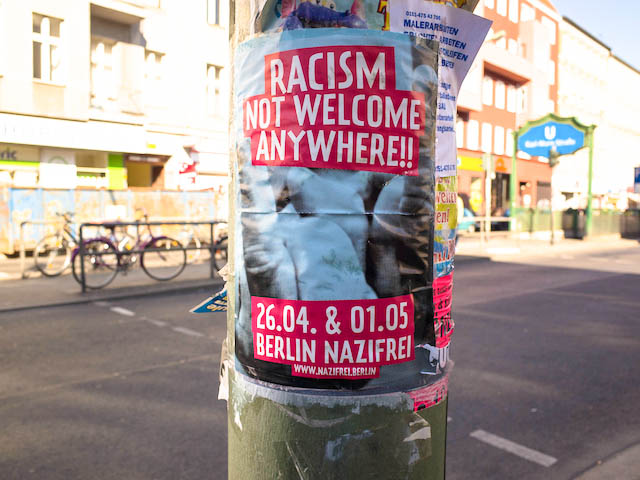The headlines got it wrong. On May 13, the Anti-Defamation League (ADL) released the results of a global survey of 100 countries that found that 26% of those surveyed crossed ADL’s threshold for anti-Semitism. The ADL said that “The survey found that anti-Semitic attitudes are persistent and pervasive around the world.” After all, they said, that 26% represents an “estimated 1.09 billion people” worldwide.
It sounds depressingly scary, doesn’t it? Since the world was forced to acknowledge the horrors of the Holocaust almost 70 years ago, Western nations – the ones responsible for that monstrosity, either by perpetrating the atrocities or by standing by quietly and allowing them to happen – have been on a campaign to eradicate anti-Semitism around the world. Yet there remain over a billion anti-Semites. That seems to speak of failure. But what happens if we take a closer look at this claim?
First, the ADL, which has long worked tirelessly to blur the line between hatred of Jews and hatred of Israel or Israeli policies, is behind the survey. That immediately necessitates some skepticism, although it hardly invalidates any of the findings in and of itself. It simply means that given the ADL’s well-established bias, we need to look more closely at the survey.
When we do, we find another problem. The questions asked are highly suspect indicators of anti-Semitism. They include, for example, a question about whether Jews are more loyal to Israel than to the countries they live in. While certainly most Jews would react harshly to accusations of disloyalty, and it is an old anti-Semitic trope, there is no reason to believe that if you asked this about other groups you would not get similar answers.
Even more dubious is the question of whether respondents believe “Jews don’t care about what happens to anyone but their own kind”? Replace “Jews” with “African-Americans,” “Latinos” “immigrants,” “Russians,” “Mexicans,” Swedes,” “Brits,” or whatever group you want. Would this not generally be something people believe about just about all national, ethnic, religious, cultural or other groups?
There are also questions that brazenly collapse the issue of Israel with anti-Semitism. This is especially true of the one about Jews wielding “too much” political influence. On so weighty an international matter as the Israel-Palestine conflict, no one who is being honest, and has even the most rudimentary knowledge of the politics of this issue denies that the organized Jewish community has worked tirelessly for decades to amass political influence very much out of proportion to its size, especially in the United States. There is, of course, nothing wrong with doing that. It’s called politics and plenty of people play that game. But there is also no avoiding the perception that a group that does it has “too much influence.” That would be true of any ethnic group that matched the lobbying success of the organized Jewish community.

There’s more, and a number of people have already done a pretty good critique of the poll. Suffice it to say, the poll is deeply flawed. But in fairness to the ADL, they certainly didn’t please anyone in the Israeli Prime Minister’s office with the finding that Iran had a lower “anti-Semitism index”, by far, than any other country in the Middle East/North Africa region.
But there are better issues to look at than that one. Let’s take the ADL’s index of 26% at face value. Polls like this one aren’t done for issues like sexism and racism, largely because the hard data of actual discrimination is more telling and more readily available. In 2006, for example, the US Department of Justice estimated that 300,000 women were raped in the United States alone. The Center for Disease Control estimates it much higher, at 1.3 million, attempting to account for the massive under-reporting of rape. Can we imagine what the numbers would look like globally, if we include places where mass rape is used as a tool of war, or where it is more stigmatized than the already considerable stigma reporting a rape carries in the United States? What does this tell us about what a misogyny index might look like?
Of course, gender inequality in material measures such as income and, education are also well-known metrics. And what about racial and ethnic discrimination? The number of groups fighting and killing one another over racial or ethnic identities are far too numerous to list here. But even in more meager ways, such discrimination finds expression. In the United States, the jobless rates for African-Americans is twice that of whites, as is median income. In many countries, racial or ethnic divides are lower, but on many other, they are as high or higher.
These are actions, and they are far more important than attitudes. I am sure a woman is bothered by a sexist attitude, but I am equally sure she is much more bothered when that attitude turns into something that costs her a job, or gets her attacked. More to the point, these physical manifestations of bigotry don’t exist in a vacuum; they must reflect an ingrained attitude that is widely shared. Of course, actions reflect attitudes, and it is wise to react to attitudes before they manifest in actions. But a reaction to attitudes alone must be kept in perspective in a world full of violent, discriminatory actions.
One point that a few people made about the ADL survey was that one country they decided not to poll was Israel. I find that interesting as well, because I have seen, among Israelis and Jews outside of Israel, attitudes about Jews that may well have surprised people. But, that aside, here’s a more interesting fact: In 2010, a poll of Israeli Jews found that “…almost half of the Jewish Israelis polled would be bothered to have an Arab neighbor.” How’s that for an attitude marker?
Here’s another. A recent survey by the Pew Research Center found that, among eight disparate European countries polled, Muslims (46%) and Roma (50%) were viewed far more unfavorably than Jews (18%). Now, let’s go back to that number, 26%.

To be fair to the ADL, some of their questions were legitimate indicators of anti-Semitism. “Jews are responsible for most of the world’s wars” is an obvious one. Not coincidentally, this was also the question which had the lowest belief score among respondents.
But as we’ve seen, this poll is just about attitudes. In fact, Jews in most places around the world where we live, are doing well financially, do not face significant workplace or housing discrimination, or an unusual rate of harassment by police or other authorities. With all of this context, what do we make of ADL’s 26%, even if we accept that figure despite the obviously flawed methodology by which it was derived?
I defy the ADL to even guess at a period of history where anti-Semitic beliefs were held by anything close to as low a number as 26%. Even more, I defy the ADL or anyone else to find a period of Jewish history where we were more comfortable in more places. The fact that 26% of people across the globe believe things that are not true about Jews reveals nothing more than that people believe a lot of stupid things.
The report has one other salient point about it: the only places where the “anti-Semitism index” was over 90% was, not surprisingly, the Occupied Palestinian Territories. There you will find many people, with no power who are dominated by a state that insists on claiming (falsely) to represent the world’s Jews. Are we to be surprised that an awful lot of them believe that “the Jews” have too much power, too much influence on other countries’ decisions, too much wealth, etc?
And that, I posit, is the real reason for the ADL’s report. No sooner had the report been issued than Israeli Prime Minister Benjamin Netanyahu pounced on it as “proof” that the Palestinian Authority “incites” hatred of Israel and Jews. As if the settlers and soldiers – who are the only examples of Jews or Israelis that Palestinians ever see anymore — don’t do that quite efficiently all by themselves. What would one expect of an occupied population, in the West Bank, and a deliberately starved and besieged one on Gaza? That these conditions would breed a great love of Jews and of Israel?
Abe Foxman and the Anti-Defamation League have long manipulated the issue of anti-Semitism to protect Israel from the consequences of its occupation and the realities of its history. Maybe this was Foxman’s grand finale, as he is due to step down next year. But he, to sustain his organization’s existence, and the Israeli government, to sustain their excuse for maintaining an unjust and illegal occupation, need the fear of anti-Semitism to stay high. In some ways, this is good; vigilance and action against any form of bigotry should be maintained until it exists no more.
But in many other ways, it is very dangerous. Israel and her supporters cry “anti-Semitism” almost constantly, whenever anyone disagrees with them or dares to criticize them. They have cheapened what should be an important issue, because it has certainly been the case in the past that when it seemed like anti-Semitism was finally receding, it came back worse than ever. But now, if that happens, who will listen? With people being brutalized, impoverished, cut off from hope and opportunity, why would the world take us seriously about anti-Semitism being a real threat again when they’ve been hearing us whine because 26% have some warped or inaccurate ideas?
The cry of anti-Semitism is becoming the cry of the wolf-shouting boy. This poll was rigged, and even so, the outcome, when put in context, reveals that anti-Semitism is far from pervasive and far from an imminent threat. Should that change, though, why would the world take us seriously anymore?
Photographs courtesy of Joel Schalit





